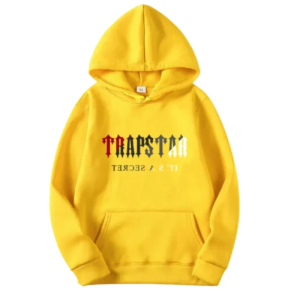The Origins of Trapstar and Its Cultural Identity
Trapstar emerged from London’s underground fashion and music scenes in the early 2000s, born out of the energy of grime, hip-hop, and street culture. Its founders created a brand that blurred the lines between fashion, music, and lifestyle, capturing the raw authenticity of the streets. The early appeal of Trapstar was not just in its clothing but in the mythos it built—exclusive drops, word-of-mouth distribution, and an aura of secrecy that made the brand desirable. Its slogan, “It’s a secret,” perfectly encapsulated the mystery that helped it gain cult status. Over time, Trapstar grew into an international streetwear powerhouse, but its expansion has been uniquely shaped by digital culture. In this new environment, the brand’s legacy is not confined to its roots but continuously expanded through global digital platforms.
Streetwear’s Symbiosis with Digital Culture
Streetwear as a whole has thrived in the digital age trapstar because its values of community, hype, and storytelling align perfectly with online platforms. Social media became the arena where limited-edition drops, collaborations, and cultural alignments reached global audiences instantly. For Trapstar, this shift was not an external adjustment but a natural continuation of its DNA. The brand always relied on networks, secrecy, and coded messages; digital platforms simply amplified this practice on a global scale. Digital culture gave Trapstar the ability to expand its legacy without diluting its underground edge, allowing it to maintain authenticity while achieving international recognition.
The Role of Exclusivity in Digital Expansion
Exclusivity has always been at the heart of Trapstar’s identity. In its early years, owning Trapstar meant being part of a select circle, a club where access was restricted. With the rise of digital culture, exclusivity has been redefined. Trapstar has leveraged online drops, surprise announcements, and limited collaborations to maintain the same sense of secrecy and desirability it was built on. The difference now is scale—what was once a London-specific phenomenon is now a global moment. Fans in Tokyo, New York, and Lagos all participate in the same drops simultaneously, experiencing the thrill of scarcity and access through digital channels. This reimagined exclusivity expands Trapstar’s legacy while staying true to its roots.
Celebrity Endorsement and Viral Visibility
Digital culture thrives on visibility, and Trapstar has benefited greatly from its connection with music and celebrity culture. From Rihanna and Jay-Z to UK rap pioneers, high-profile figures have worn Trapstar both onstage and online, giving the brand global visibility. These celebrity endorsements are amplified through social media, where images of stars in Trapstar spread instantly to millions of followers. Each viral moment becomes part of the brand’s digital archive, layering its cultural legacy with moments of global recognition. The digital sphere ensures that these moments are not fleeting—they are replayed, reposted, and reinterpreted, keeping the Trapstar legacy alive in the collective memory.
Digital Communities as Cultural Custodians
Beyond celebrities, digital communities play a critical role in expanding Trapstar’s legacy. Online forums, Instagram fan accounts, and TikTok style communities act as custodians of the brand’s culture. They archive collections, resurface past collaborations, and discuss future drops, creating a living history that extends beyond the brand’s official narrative. Trapstar’s digital legacy is thus co-created with its community, ensuring that the brand does not simply dictate culture but shares it with those who support it. This participatory dynamic strengthens its authenticity, making its digital presence not a marketing strategy but a cultural dialogue.
Collaboration in the Digital Age
Trapstar’s collaborative spirit has been amplified by digital culture. Partnerships with major names like Puma or musical collectives gain far greater visibility through online platforms than they ever could through traditional retail. Each collaboration becomes a digital event, complete with teaser campaigns, countdowns, and viral launches. The Essentials of streetwear collaboration—exclusivity, hype, and cultural crossover—are magnified in the digital age, where visibility extends far beyond local communities. For Trapstar, collaborations are no longer confined to physical garments; they exist simultaneously as cultural images circulating online, becoming part of the brand’s global legacy.
Resale Markets and the Digital Afterlife of Products
Another crucial aspect of digital culture’s influence is the rise of resale markets. Platforms like Grailed, Depop, and StockX give Trapstar products a second life, where their value is determined by demand and rarity. This digital afterlife ensures that Trapstar pieces do not fade into obscurity after their initial drop but continue to circulate as coveted cultural artifacts. The resale economy reinforces the brand’s legacy by keeping its older collections relevant, reminding consumers that Trapstar’s cultural weight extends beyond its latest releases. Each hoodie, jacket, or cap becomes part of a larger narrative of desire, scarcity, and status.
Global Reach Through Digital Connectivity
Trapstar’s expansion from London to a global audience would not have been possible without digital connectivity. The internet flattened cultural hierarchies, allowing a brand rooted in London street culture to resonate in diverse contexts worldwide. Fans in Asia, North America, and Africa connect with Trapstar not just through physical products but through shared digital experiences. Hashtags, digital campaigns, and viral collaborations create a sense of global community around the brand. In this sense, Trapstar’s legacy is no longer tied only to geography but to a digital network that spans the world, ensuring its relevance across borders.
Balancing Legacy and Innovation
As Trapstar navigates digital culture, it faces the challenge of balancing legacy with innovation. The brand’s identity is rooted in secrecy and underground credibility, yet digital platforms demand visibility and openness. Maintaining this balance is part of what makes Trapstar’s story compelling. By carefully managing how much it reveals and how it engages with its audience, Trapstar preserves its mystique while still thriving in the age of digital transparency. This balancing act ensures that the brand’s legacy expands without losing the edge that made it iconic in the first place.
The Future of Trapstar’s Digital Legacy
Looking forward, Trapstar’s digital presence will continue to shape its legacy. As technology evolves, from augmented reality fashion shows to digital collectibles and virtual wearables, the brand has opportunities to expand its influence in new directions. Trapstar’s ethos of secrecy and coded communication fits naturally into digital culture’s fascination with hidden drops and exclusive access. Its future legacy will likely involve blending physical and digital worlds, ensuring that its cultural presence trapstar t shirt remains strong in both. By continuing to evolve while preserving its underground DNA, Trapstar secures its place as a brand that understands how legacy is built in the twenty-first century.
Conclusion: Digital Culture as the Amplifier of Legacy
Trapstar’s journey from underground London label to global streetwear force is a testament to the power of digital culture in expanding legacy. Exclusivity, celebrity visibility, online communities, and resale markets have all amplified the brand’s identity far beyond its original scope. Digital culture does not erase Trapstar’s roots; instead, it magnifies them, making its slogans, collaborations, and designs resonate worldwide. In this sense, Trapstar represents a new model of legacy-building—one that does not rely solely on heritage or geography but on the ability to thrive in digital networks. Its expansion is not just about fashion but about cultural memory, ensuring that the Trapstar name continues to carry weight for generations to come.



